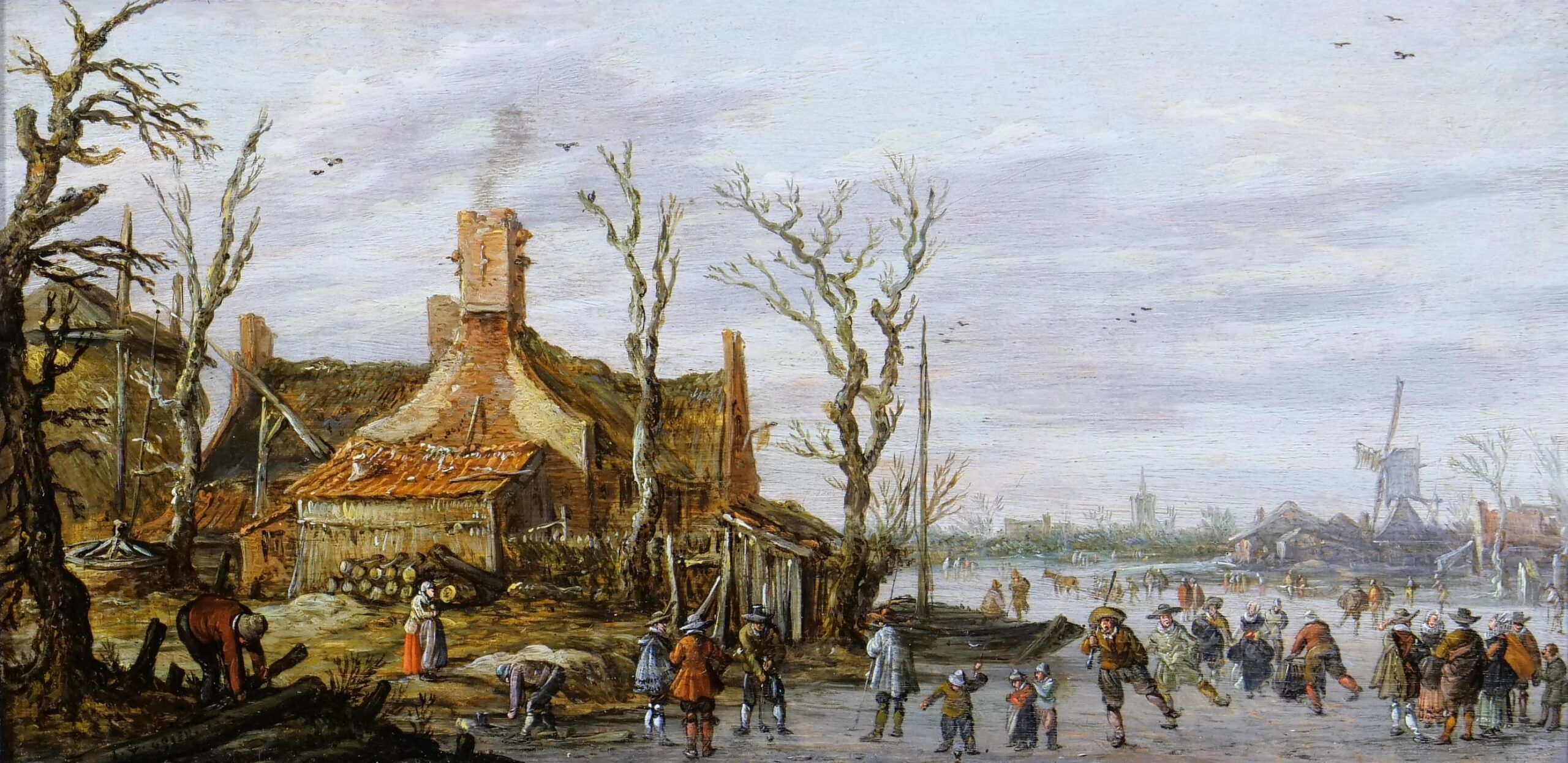Leiden 1596 – The Hague 1656
A Winter Landscape with Skaters, elegant Figures and Kolf Players on the Ice in a Village
Signed and indistinctly dated ‘I.V. GOYEN. 162.‘, lower left
Oil on panel
H. 13,6 cm. W. 26,8 cm.
PROVENANCE
Anonymous sale | Drouot | Paris | 21 March 1874 | Lot 23 (Frs. 510), erroneously as a pendant to the consecutive lot
Collection Comte de Camondo | Galerie Georges Petit | Paris | 1 February 1893, | Lot 6 (Frs. 1.700), were acquired by W. Gretor
Anonymous sale | Drouot | Paris | 18 February 1895 | Lot 13 (Frs. 750), were acquired by Lange
Collection G. Forbes | London (according to Dayot and Hofstede de Groot)
Sale Jules Cronier | Galerie Georges Petit | Paris | 11 March 1908 | Lot 88 (Frs. 1,200), were acquired by Kleinberger, Paris
With Kleinberger | Paris
Collection Eugène Max | Paris | By 1911 and up to 1927
With Grange | Paris;
Private collection | Paris | By 1965
Anonymous sale | Sotheby’s | London | 1 March 1992 | As lot 36 (£ 101,200)
With John Mitchell | London | By 1993
Anonymous sale | Christie’s | Amsterdam | 20 November 2012 | As lot nr. 68 (211.000 Euro)
With Johnny van Haetfen Ltd. | London, by 2014 (ref. VP4577), where acquired by the previous owner
Private collection | The Netherlands
LITERATURE
Dayot, A. (1911). Grands & petits maîtres hollandais, exhibition publication. Paris, nr. 42;
Martin, W. (1918). Alt-Holländische Bilder. Berlin, p. 51, fig. 25;
Hofstede de Groot, C. (1927). A catalogue raisonné of the works of the most eminent Dutch painters of the seventeenth century. London, Vol. VIII, p. 294, nr. 1170;
Beck, H.-U. (1972). Jan van Goyen 1597-1656. Amsterdam, Vol. II, p. 46, nr. 88 (illustrated, erroneously as a pendant to nr. 244)
EXHIBITION
Paris | Salle du Jeu de Paume, Grands & petits maîtres hollandais | 28 April-10 July 1911 | Nr. 40 bis
Maastricht | TEFAF | 2014
RECORD
The present painting is recorded at the RKD | The Hague | Nr. 235652
CATALOGUE NOTE
The son of a cobbler, Van Goyen was apprenticed to a variety of Leiden-based artists before training from 1617-18 onwards with Esaias van de Velde in Haarlem. Van de Velde, his senior by six years, had a major impact on the younger artist, and his mark is particularly clearly visible in Van Goyen’s work of ca. 1618-26. The present work, which can stylistically be dated to the mid-1620s (ca. 1623-1627), is a fine example of Van Goyen’s early style and attests strongly to the influence of his teacher. Here, Van Goyen employs the format of constructing the composition from clear gradations of perspective, which was taken by Van de Velde from Flemish tradition. The dark solidity of the tree and the wood gathering figure in the left foreground, form a stark repoussoir and contrasts sharply with the frozen natural landscape. The centre of the composition is accentuated by the colourful figures and local colouration, set against the expeditiously and monochrome painted windmill, church and village in the third plane. The present picture however also presages the characteristic elements of Van Goyen’s later oeuvre, characterised by a more monochromatic palette, greater naturalism and strongly horizontal compositions with a low horizon, only broken up by the verticality of the trees.
Winter scenes were a particularly popular theme for Dutch painters of the seventeenth century and found their roots in the earlier winter landscapes of Flemish artists like Pieter Bruegel the Elder. Such paintings allowed artists like Van Goyen, Esaias van de Velde and Hendrick Avercamp to indulge themselves in the depiction of a broad spectrum of society engaged in leisure activities. Van Goyen’s acute observation is evident here in the myriad of figures who skate, stride and slide across the flat, frigid landscape. Most notable are the pair of figures in the foreground who engage in a game of kolf, a predecessor of the modern game of golf. Kolf originated in the Middle Ages and involved the use of a club to knock a ball towards a target. The sport grew so popular in the urbanised Dutch environment and its players so rowdy from too much drink that the resulting damage to personal property induced a number of city councils to pass laws restricting its play to the countryside.
This finely executed picture, with its rare and interesting kolf them, is therefore not only a true masterpiece in its own right, but also a fine example of the skills and the steep development of a highly talented artist, who would become one of the exceptional exponents of Dutch 17th century landscape painting.

